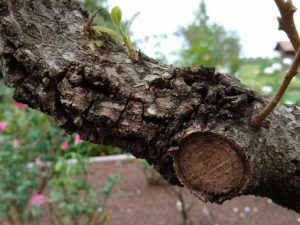Canker diseases are common, widespread and destructive to a wide range of trees and shrubs. A ‘canker’ is really a symptom of an injury often associated with an open wound that has become infected by a fungal or bacterial pathogen. Canker diseases frequently kill branches or structurally weaken a plant until the infected area breaks free, often due to wind in Florida.
 Cankers can vary considerably in size and shape. Typically, they appear as localized, sunken, slightly discolored, brown-to-reddish lesions on the bark of trunks and branches or as injured areas on smaller twigs. The bark often splits between the diseased and the healthy tissue, and sometimes it may ooze sap or moisture. The inner bark turns black and sometimes gives off a foul odor.
Cankers can vary considerably in size and shape. Typically, they appear as localized, sunken, slightly discolored, brown-to-reddish lesions on the bark of trunks and branches or as injured areas on smaller twigs. The bark often splits between the diseased and the healthy tissue, and sometimes it may ooze sap or moisture. The inner bark turns black and sometimes gives off a foul odor.
The newest leaves on affected branches are usually the first to show decline symptoms. Leaves may appear smaller than normal, pale green to yellow or brown, often curled and sparse. As the fungal pathogen invades bark and sapwood, the water-conducting tissues (vascular system) become blocked or die, causing wilting and dieback to occur. Cankers can take months or years to enlarge enough to girdle twigs, branches or trunks.
Canker and stem dieback diseases are most common on trees and shrubs under stress. Damage results when opportunistic, living (biotic), infectious fungi or bacteria enter a wound during a time of plant stress, such as transplant shock, drought, prolonged exposure to extremely high or low temperatures, flooding, hail, high winds, nutritional imbalances, soil compaction, mechanical injuries (lawn mower, vehicles), animal damage, pruning wounds, root rot, insect borers and improper planting.
- Cankers are difficult to control. No chemicals are universally registered for treatment of cankers. The best controls to keep plants healthy are preventative ones or to prune out the diseased plant parts when practical.
- Grow only trees and shrubs that are adapted to the area and site and select resistant varieties.
- Keep plants healthy and vigorous through proper planting, mulching, watering, soil management, pruning and winter protection practices.
- Avoid all unnecessary bark wounds, because many pathogens’ main entry is through injuries.
- If a canker infection occurs on twigs or branches, carefully remove the affected parts several inches behind the infection. Pruning cuts should be made at the branch collar and avoid leaving stubs.
- To reduce spread of the fungus, do not prune when the bark is wet. Between cuts, pruning tools should be sterilized using rubbing alcohol or 10% household bleach.
- Once a trunk canker develops, the tree may begin to seal off the area by forming a callus around the canker. Avoid cutting into such cankers because it may renew fungal activity and increase damage. Any type of trunk canker removal is best left to a professional certified arborist.
Excerpted from the Morton Arboretum: https://www.mortonarb.org/trees-plants/tree-and-plant-advice/help-diseases/canker-diseases
 0
0
